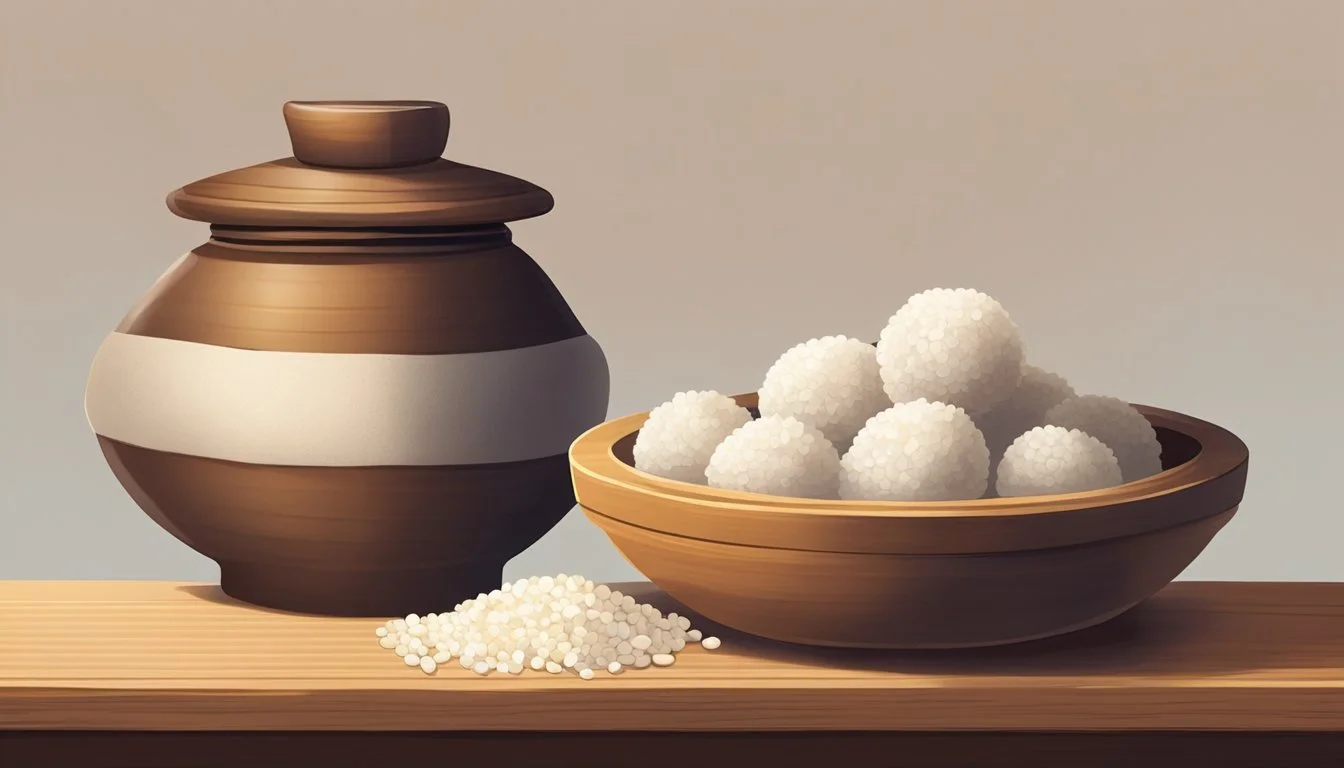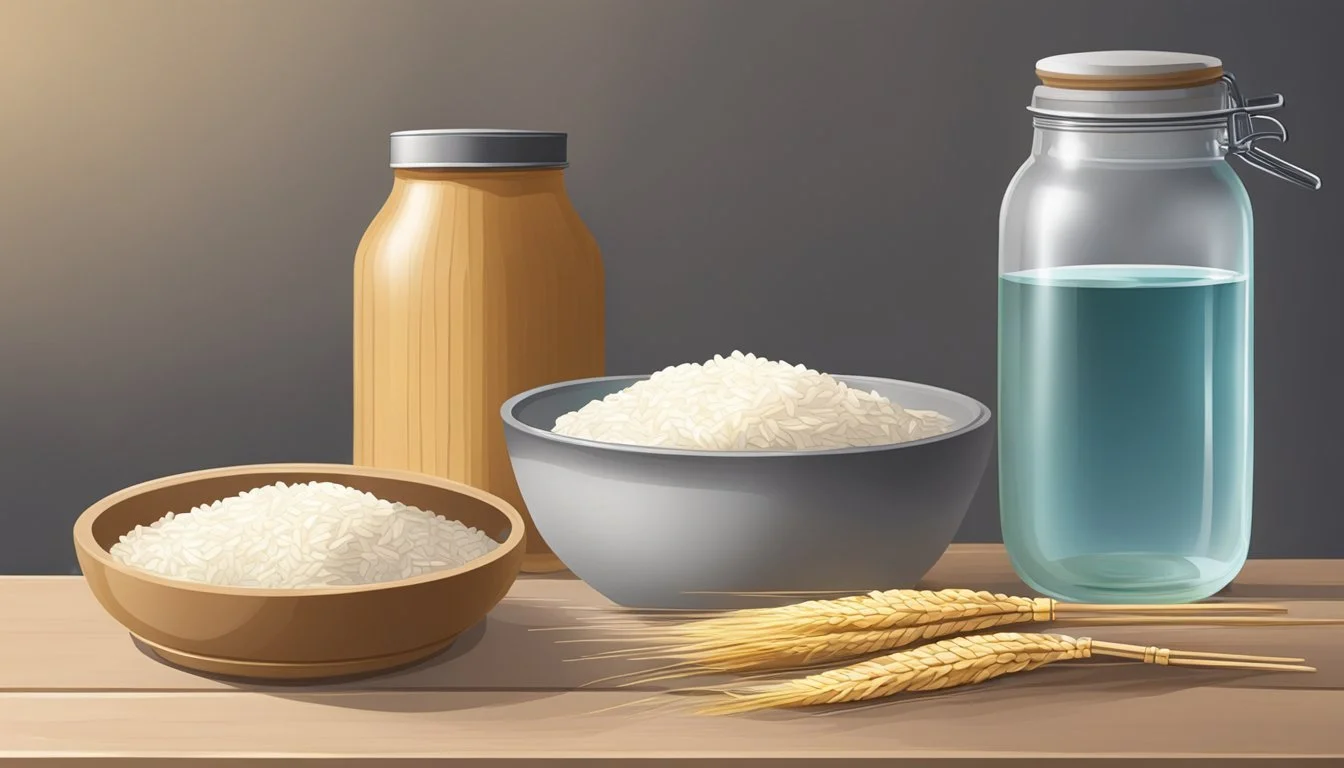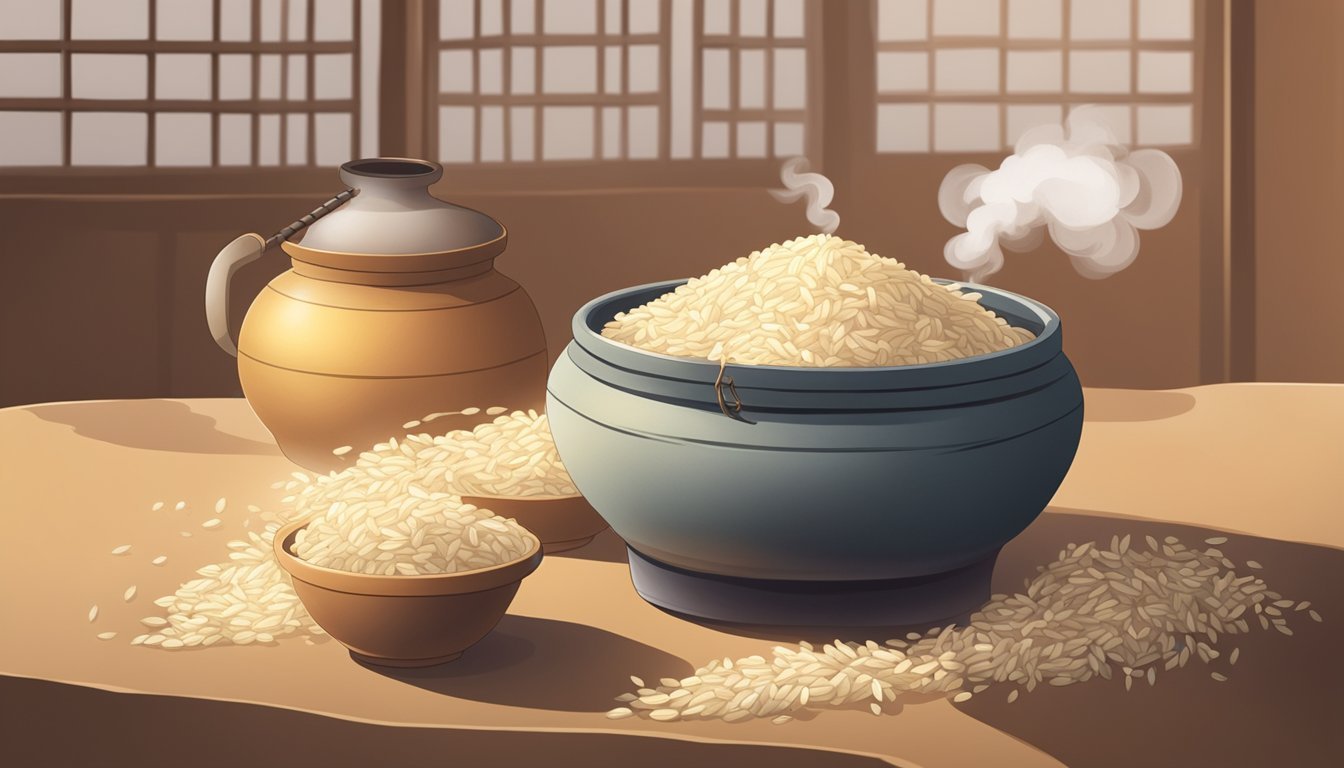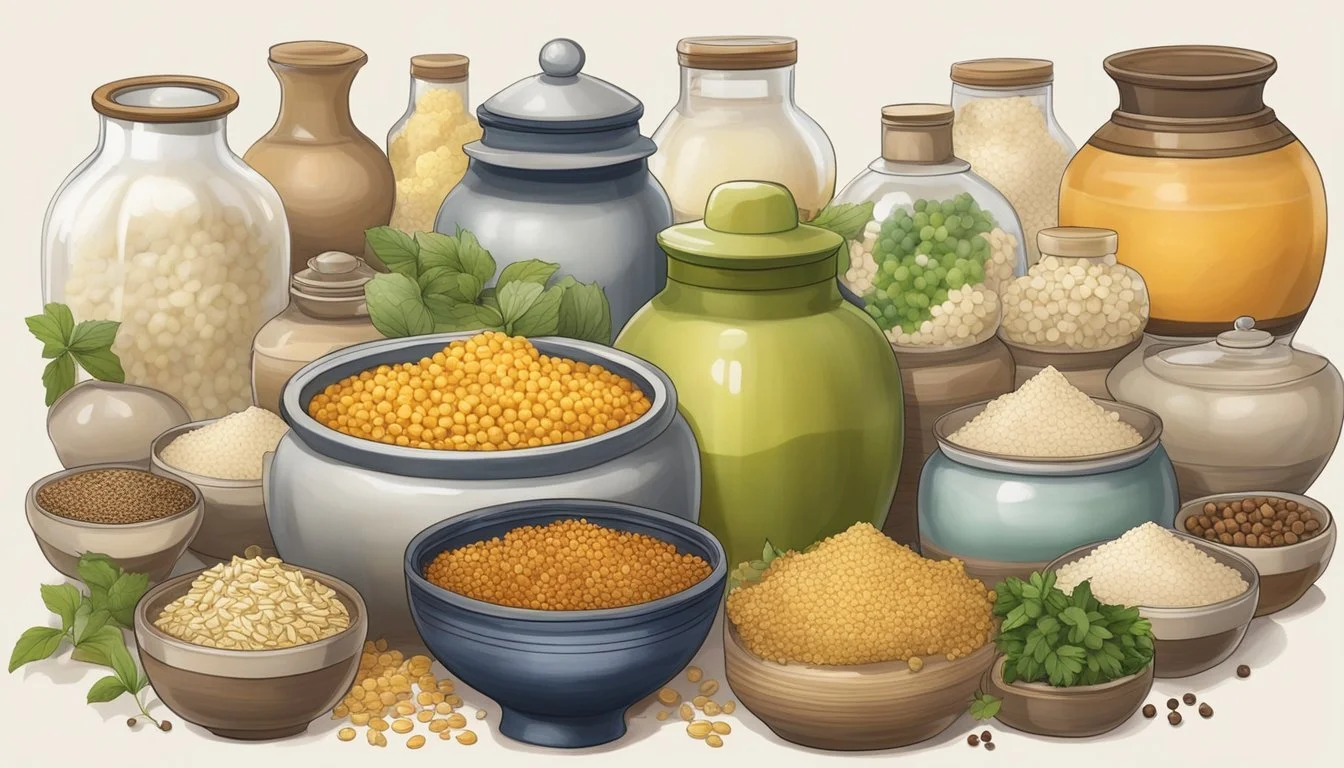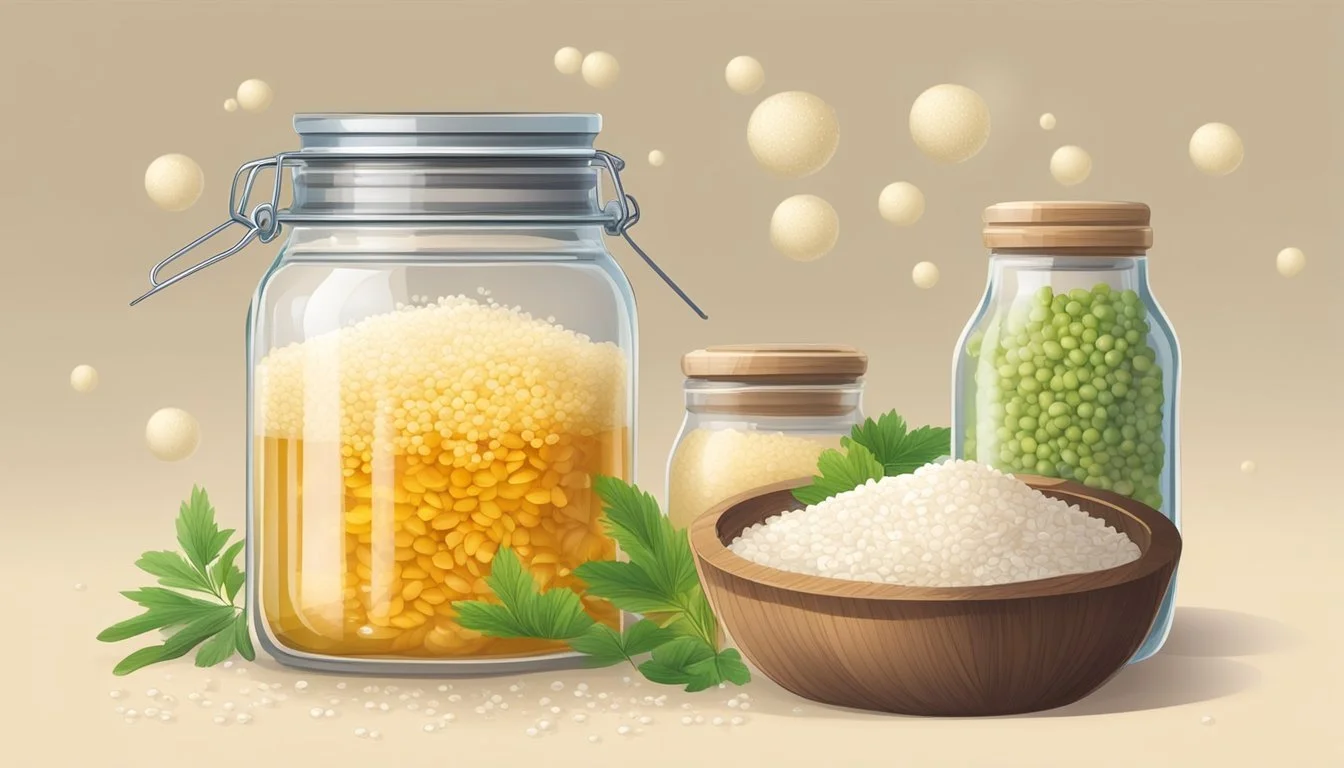How to Ferment Choujiu
Your Guide to Crafting Traditional Chinese Rice Wine
Choujiu is a type of Chinese fermented rice wine with a long-standing position in the culinary traditions of China. It's characterized by its sweet taste and milky appearance, a result of the fermentation process that breaks down the rice starches into sugars, which are then converted into alcohol and other flavorful compounds. The texture can range from slightly chewy grains suspended in wine to a smooth, porridge-like consistency, depending on the length of fermentation and specific methods used.
Fermenting Choujiu involves a unique blend of techniques, patience, and a few key ingredients, most notably the Chinese yeast balls known as "qu" which facilitate the fermentation process. The basic steps typically include soaking and steaming glutinous rice, cooling it down, and then introducing the yeast to initiate fermentation. The sweet and slightly alcoholic beverage that emerges is not only enjoyed as a drink but also used as a base in various Chinese delicacies, both sweet and savory.
Crafting this wine at home is becoming popular as enthusiasts seek to reconnect with traditional practices and savor authentic flavors. While the process is relatively simple, it requires precision and attention to detail to achieve the desired outcome. Storage conditions, timing, and hygiene play crucial roles in the success of homemade Choujiu, making the process a rewarding challenge for those who undertake it.
Understanding Choujiu
Choujiu is a traditional Chinese fermented rice wine with a rich cultural background and potential health benefits. This sweet rice wine is made from glutinous rice and is often enjoyed during Chinese New Year and other festivities.
History and Cultural Significance
Choujiu has been an integral part of Chinese culture for centuries, often associated with traditional festivities and celebrations. It is a sweet rice wine derived from the fermentation of glutinous rice, which imparts its distinctive milky white color and thick consistency. This beverage parallels the Japanese sake, but it retains a unique character due to its sweeter profile and creamier texture.
The preparation of Choujiu typically begins with steaming glutinous rice until it is fully cooked. Following this, a fermentation agent typically known as Chinese yeast balls (Jiuqu) is added. The rice wine is allowed to ferment, a process that may range from several days to months, depending on the desired sweetness and potency of the final product. Choujiu is not only a beverage but also serves as a traditional Chinese dessert and is a component in certain dishes, showcasing its versatility in culinary practices.
Significantly, Choujiu is a fixture in Chinese New Year celebrations. It exemplifies the intricate relationship between food, beverage, and cultural expression within Chinese society.
Health Benefits
Choujiu and other forms of Chinese fermented rice, such as Tapai, are believed to offer nutritional and health benefits. The fermentation process not only develops the unique flavors of this wine but also enhances its nutritional profile. Fermented foods, (What wine goes well with fermented foods?) in general, are noted for their probiotic qualities, potentially aiding in digestion and promoting a healthy gut microbiome.
The wine contains various vitamins and minerals that are inherent to glutinous rice, enriching its nutritional value. Traditional Chinese Medicine often recognizes fermented glutinous rice for its supposed therapeutic properties, suggesting it can assist with digestive health and vitality.
While these benefits add to the allure of Choujiu, it should be noted that claims surrounding the health impacts of alcoholic beverages should be approached with caution, as excessive consumption can lead to adverse health consequences.
Ingredients and Tools
When embarking on the journey of fermenting Choujiu, the traditional Chinese fermented rice wine, understanding and sourcing the correct ingredients and tools is essential. The quality and type of rice can significantly influence the flavor of the wine, while the proper tools and sanitation practices ensure a successful fermentation process.
Choosing the Right Rice
The foundation of Choujiu is glutinous rice (Oryza sativa glutinosa), also known as sticky rice. This variety of rice is key due to its high starch content, which is crucial for the fermentation process. For Choujiu, one may opt for either short-grain or long-grain glutinous rice, with short-grain being the traditional choice. It is important that the rice is well-rinsed and prepared properly to ensure a clear final product.
Fermentation Essentials
The heart of the Choujiu fermentation process is the fermentation starter. This is typically a Chinese rice wine yeast known as 酒曲 (jiuqu) or yeast balls. These starters contain a mix of yeast and mold spores that facilitate the conversion of rice starches into sugars and then alcohol. For the fermentation to proceed efficiently, precise control of fermentation temperature is required, with the ideal range being between 25°C to 30°C. Add water to just cover the rice and the starter to initiate the fermentation process.
Utensils and Sanitation
To make Choujiu, it’s necessary to have a steamer capable of cooking the rice thoroughly. Once the rice is cooled to room temperature, a clean spoon or similar utensil must be used to evenly distribute the crushed yeast balls over the rice. When handling ingredients and during the fermentation process, utilizing glass or plastic containers that have been properly sanitized helps prevent contamination. The importance of cleanliness cannot be overstated; all utensils must be sanitized to ensure a pure and safe product.
Pre-Fermentation Process
The pre-fermentation stage for creating Choujiu, a type of Chinese fermented rice wine, is critical for setting the stage for successful fermentation. It involves soaking and steaming sweet rice, then cooling it and preparing it for the introduction of fermentation agents. Attention to detail during this phase ensures a good base for developing the wine's desired sweet flavor and aroma.
Soaking the Rice
Soaking is essential for achieving the right softness in the rice grains. Sweet rice, also known as glutinous rice, should be thoroughly washed to remove any impurities and then soaked in cold water. They should soak for a period usually ranging from 4 to 8 hours, or until the rice grains have absorbed enough water to become pliable. This step ensures that steam can effectively penetrate the grains during cooking.
The Steaming Method
Cooking the soaked sweet rice properly is crucial for Choujiu.
Cooking method: Rather than boiling, the rice is best cooked with steam to maintain its integrity and prevent it from becoming too soggy.
Equipment: A rice cooker can be used if it has a steaming feature; otherwise, a traditional steamer is preferred.
Process: Spread the rice evenly on a cloth lined inside the steamer to allow even distribution of heat.
Duration: Steam the rice for approximately 30 to 40 minutes. The rice should be completely cooked through, turning translucent when it's done.
Cooling and Preparing for Fermentation
Once the rice is steamed, it requires proper cooling.
Spread: It should be spread out on a clean tray to avoid clumping and to facilitate even cooling.
Ambient Temperature: It's important for the rice to cool down to about room temperature.
Aroma: Optionally, some may choose to incorporate aromatic elements such as osmanthus flower during this stage to add a unique fragrance to the sweet fermented rice.
Preparation for Fermentation: After the rice has cooled, it's ready to have the fermentation agents mixed in, which will be covered in the following stages of the fermentation process.
The Fermentation Stage
The fermentation stage is critical in the production of Choujiu, a Chinese fermented rice wine, where yeast transforms rice starches into alcohol and flavor compounds.
Initiating Fermentation
The fermentation process begins by introducing a rice wine starter or 酒曲 (jiuqu), to the cooked rice. This starter is essentially a fermentation agent that includes a mix of yeast, Rhizopus, and other microorganisms that initiate saccharification, converting the rice starch into glucose. For a successful fermentation start, the starter is usually grounded into fine powder and evenly sprinkled over the cooled, cooked rice ensuring proper mixing.
Fermentation Conditions
To effectively ferment Choujiu, maintaining optimal fermentation conditions is crucial. The fermentation temperature should consistently be warm, around 25-30°C, to encourage yeast activity without risking the growth of undesired microorganisms that can lead to contamination. The wine should be stored in a clean, airtight container to eliminate the chance of exposure to unwanted microbes while allowing carbon dioxide, a by-product of fermentation, to escape.
Factor: Temperature, Optimal Condition: 25-30°C
Factor: Environment, Optimal Condition: Clean, airtight container
Factor: Humidity, Optimal Condition: Moderate
Monitoring the Process
Throughout the fermentation, it's essential to monitor both the alcohol content and the flavor development. Depending on the desired sweetness or sourness, fermentation time can vary, typically ranging from a few days to a few weeks. Constant monitoring will alert the brewer if the wine becomes too sour or remains too sweet, indicating either over-fermentation or incomplete fermentation, respectively. The presence of bubbles and the gradual development of a pleasant, alcoholic fragrance are signs of active fermentation and production of carbon dioxide and alcohol.
Post-Fermentation Steps
After fermenting Choujiu, the critical steps that follow are maturing and packaging the wine, both of which play pivotal roles in developing its characteristic sweetness, aroma, and flavor.
Maturing the Choujiu
Once fermentation is complete, the Choujiu must be allowed to mature. This process is crucial for the wine to develop its full flavor profile. The Choujiu should be transferred into clean storage containers, such as ceramic jars or glass containers, which are non-reactive materials that do not impart unwanted flavors or chemicals into the wine. During maturation:
The sweetness and aroma of the Choujiu will become more pronounced.
The wine should be stored in a cool, dark place to prevent deterioration of flavor.
Glass containers are preferable for smaller batches, while ceramic vessels can be used for larger quantities.
Packaging and Storage
Proper packaging and storage are essential for maintaining the wine's quality. Before packaging:
Ensure that the Choujiu has reached its desired level of sweetness and flavor.
Sterilize all glass bottles or plastic containers to prevent contamination.
For packaging and storage:
Glass bottles with airtight seals are ideal to retain the Choujiu's delicate aroma and flavor.
Label the containers with the date of bottling.
Store the Choujiu in a fridge or another cool environment to preserve its quality.
Depending on preferential taste, Choujiu may be consumed immediately for a sweeter flavor or stored longer for more complexity.
Serving and Pairing
Choujiu is a unique Chinese rice wine that offers a sweet, fermented flavor profile. Its cloudiness and distinctive sweetness make it a choice beverage for certain occasions and food pairings. Here are some suggestions on how to serve Choujiu and maximize its compatibility with different culinary flavors.
Serving Suggestions
One should serve Choujiu chilled or at room temperature, depending on personal preference. It is traditionally enjoyed from small ceramic cups or bowls and is often sipped slowly to savor its complex flavors. Sweet fermented rice, or lao zao, which is a byproduct of making Choujiu, can also be served as a warm dessert or be incorporated into Chinese dessert dishes for an added depth of flavor.
Pairing with Foods
Choujiu pairs exceptionally well with both savory dishes and desserts. Its sweet nature complements the richness of savory foods, such as:
Savory Dishes:
Braised pork
Spicy tofu
Roasted duck
In contrast, the wine's distinctive sweetness makes it an ideal companion for a variety of desserts:
Desserts:
Red bean paste buns
Egg tarts
It also offers a lovely contrast when enjoyed with spicy or heavily seasoned foods, providing a pleasant, soothing effect on the palate. Additionally, Choujiu can be used in the preparation of certain soups to introduce a sweet undertone that enriches the overall flavor of the dish.
Advanced Tips and Variations
When fermenting Choujiu, a traditional Chinese sweet rice wine, the adventurous brewer may wish to experiment beyond the basic recipe to create a unique homemade variant. The incorporation of assorted flavors and the manipulation of texture can lead to a more personalized and enhanced experience.
Experimenting with Flavors
To give Choujiu a distinctive twist, experimentation with various additives can enrich the aroma and taste. Here are specific ways to infuse flavor into the sweet wine:
Fruits: Incorporate fruits like lychees, peaches, or pomegranates during fermentation to achieve a fruity undertone.
Botanicals: Herbs such as lemongrass or a hint of ginger root can add a refreshing zing.
Infusion: After fermentation, steeping the wine with ingredients like osmanthus flowers or red dates can introduce new flavors.
The alcohol content of Choujiu typically ranges from 2.5% to 3.5%, but by varying the fermentation time or the rice to water ratio, one can slightly adjust the alcohol level to suit their taste preferences. However, this requires precise control to avoid over-fermentation, which could lead to a strong alcoholic taste overshadowing the delicate sweetness of the rice wine.
Customizing Texture
Achieving the desired texture in Choujiu depends largely on the rice preparation and the fermentation process:
Rice Preparation:
Soak the sweet rice (sticky rice) for 4-5 hours or overnight for optimal absorption, aiding in a smoother texture post-fermentation.
Use a ratio of one cup of water to every two cups of rice to create a soft, but not mushy, consistency.
Controlled Fermentation:
Ferment in a consistently warm environment to maintain the growth of yeast from the rice balls (starter), ensuring a uniform transformation into a porridge-like consistency.
One may optionally stir the mixture every few days to break down the sticky rice balls further and achieve a silkier texture.
As Choujiu matures, the balance between the sweet flavor profile and the porridge-like consistency offers a sensory delight, commonly served as a traditional Chinese dessert. Careful attention during preparation and fermentation can enhance both the taste and the mouthfeel, creating a personalized version of this age-old delight.
Troubleshooting Common Issues
When fermenting Choujiu, certain challenges such as contamination or inconsistencies in fermentation variables can arise. Addressing these issues effectively is crucial for a successful batch of rice wine.
Avoiding Contamination
Contamination can sour the taste of Choujiu, rendering it unpleasant. To prevent this:
Sanitize: All utensils and containers should be thoroughly sanitized before use. Boiling them in water for at least 10 minutes or using a food-grade sanitizer can be effective.
Use Clean Rice: The rice should be well-rinsed until the water runs clear to remove impurities that could harbor bacteria.
Sterile Environment: Keep the fermentation area free of contaminants and dust. It's best to cover the fermenting vessel with a clean, boiled cloth or lid.
Adjusting Fermentation Variables
The outcome of Choujiu heavily depends on the fermentation environment:
Starter Culture: Use high-quality rice wine yeast and ensure it is fresh. A stale or improper starter can lead to failed fermentation.
Temperature Control: Maintain a consistent fermentation temperature, suggested between 60-68°F (15-20°C) for optimal yeast activity.
Time Monitoring: Fermentation time affects the wine's sweetness. A shorter ferment yields a sweeter taste, while longer periods may produce a drier wine with potential sour notes.
Sweetness Adjustments: If the Choujiu is too sweet, extending the fermentation may help. If too sour, checking for contamination and the quality of the starter is necessary.
Showcasing Choujiu
The visual appeal of Choujiu is just as important as its flavor. Proper presentation enhances the experience of enjoying this traditional Chinese rice wine.
Photography and Presentation
For photographing Choujiu, one should focus on capturing the texture and color of the wine. A high-resolution image that shows the creamy, opaque nature of Choujiu can be very appealing. Instagram is a popular platform for sharing such images, and using natural lighting can help emphasize the subtle hues and cloudiness.
When presenting Choujiu for serving, clarity in glassware choice communicates sophistication. A transparent glass allows the viewer to appreciate the wine's unique characteristics, while a ceramic cup offers a nod to the traditional methods of serving Chinese rice wines. It's advisable to consider the backdrop as well—the contrast of the vessel against a muted background can make the colors pop.
For the full presentation effect, accessorizing with Chinese desserts can create a harmonious image. Small, delicate sweets on a plate accompanying Choujiu set a scene for indulgence. One could even place a pair of chopsticks alongside, hinting at a complete cultural gastronomic experience. This level of detail not only provides a feast for the eyes but also invites viewers to imagine the taste and texture of Choujiu.
Choujiu in Modern Cuisine
Choujiu, a traditional Chinese fermented rice wine, has found its place in modern cuisine through innovative recipes and health-centric adaptations. It integrates the time-honored fermentation techniques with contemporary culinary practices.
Culinary Innovations
Chefs and food enthusiasts incorporate Choujiu into various dishes, elevating their flavor profiles with its unique sweet and tangy taste. Here are some specific ways in which Choujiu is used in modern cooking:
Sauces: A reduction of Choujiu adds a complex flavor to sauces for meats, fish, and as a base for vinaigrettes.
Desserts: Utilized in desserts, such as in poached pears or rice pudding, imparting a subtle wine-infused aroma.
Marinades: This fermented wine is excellent for marinating proteins, infusing them with deep flavors before cooking.
Health Conscious Recipes
The health aspects of Choujiu have also encouraged its inclusion in diets that focus on well-being. The following points highlight its health-conscious use:
Nutrient-Rich: Choujiu contains nutrients brought about by the fermentation process, including beneficial enzymes that can aid in digestion.
Low-Alcohol Content: As an alcohol, it is comparatively low in alcohol content, making it a gentle addition to health-focused recipes.
Complex Carbohydrates: Fermented foods like Choujiu are known to contain complex carbohydrates that can provide steady energy release.
Cooking directions often recommend using Choujiu sparingly to complement, not overpower, the main ingredients. Its utility extends beyond adding a burst of flavor; it brings with it the health benefits associated with fermented foods, making it a versatile ingredient in a nutritionally aware kitchen.
Resources and Further Learning
For enthusiasts eager to dive deeper into the craft of fermenting Choujiu, a traditional Chinese sweet rice wine, a wealth of resources is available. These resources provide comprehensive information on the fermentation process, the use of specific starters such as Chinese rice wine yeast, and detailed recipes and directions for making authentic jiu niang.
Books and Online Resources
Books: Readers can find an array of books offering detailed insights into Chinese fermentation traditions. These often include recipes and step-by-step guidance on creating Choujiu and other variations of Chinese sweet fermented rice.
The Art of Fermentation by Sandor Ellix Katz
Chinese Rice Wine Cookbook by Huang Fei-Hong
Online Resources: Various websites and online platforms offer valuable content ranging from beginner-friendly directions to advanced techniques.
The Woks of Life: Features a recipe for Sweet Fermented Rice (jiu niang) with practical tips.
Chinese Recipes at Home: Provides instructions for homemade jiu niang.
Workshops and Tastings
Workshops: Attending workshops provides hands-on experience and the opportunity to interact with experts in the field. Many workshops guide participants through the process of making Choujiu, from selecting the right type of glutinous rice to using powdered yeast.
Tastings: Engaging in tasting events can help enthusiasts understand the flavor profiles of different varieties of Choujiu and sake, enhancing their appreciation and knowledge of sweet rice wines.

